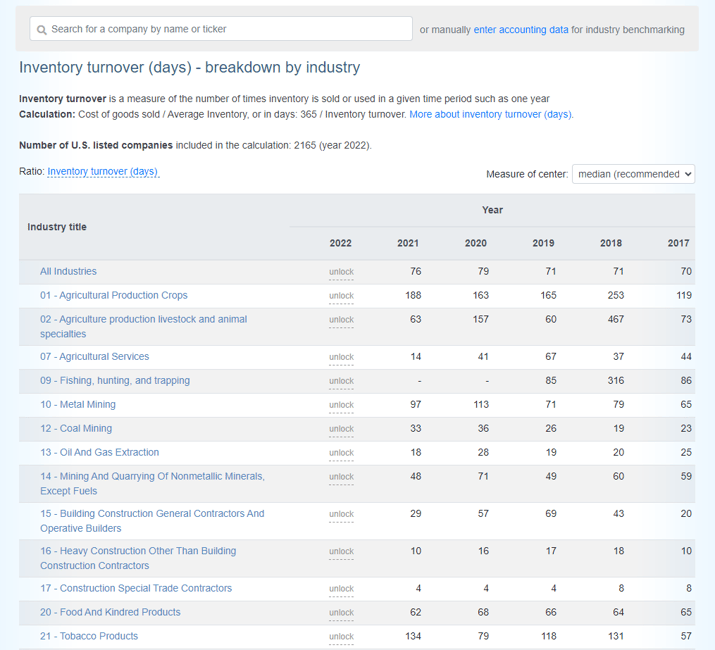The answer to the question, "What is a good inventory turnover ratio?" is the midpoint between two extremes. You don't want your merchandise gathering dust; however, you don't want to have to restock inventory too often. The golden ratio is somewhere in between.
In this article, we'll discuss how to find the ideal turnover ratio considering your industry and size and share practical tactics for reaching that goal.
- Your inventory turnover ratio (ITR) is the number of times you sell all your inventory over a given period of time (such as a year). You can calculate it using the inventory turnover ratio formula:
- Cost of goods sold (COGS) / average inventory value.
- So, if your COGS for 2019 totaled $300,000 and your inventory was worth $60,000, your ITR would be 5.
We will help you interpret that number and target the optimal inventory level for your business and industry.
What is Inventory Turnover Ratio?
Inventory Turnover Ratio, or Inventory Turnover, measures how quickly a company sells and replenishes its inventory over a specific period. It’s calculated by dividing the cost of goods sold by the average inventory for the same given time period.
A high inventory turnover ratio indicates that a company is efficiently managing its inventory, which can lead to lower holding costs and potentially higher profits. On the other hand, a low ratio suggests that a company may be overstocked, which can lead to higher holding costs and potentially obsolete inventory.
In simple terms, inventory turnover ratio reflects how fast a company sells an item and is used to measure sales and inventory efficiency. Inventory turnover is also known as inventory turns, stock turnover or stock turn.
What Is a Good Inventory Turnover Ratio?
A good inventory turnover ratio is between 5 and 10 for most industries, which indicates that you sell and restock your inventory every 1-2 months. This ratio strikes a good balance between having enough inventory on hand and not having to reorder too frequently.
Some organizations, such as ReadyRatios, track the median ITR in various industries. But while those numbers are good to know, your industry's average ITR isn't necessarily a good inventory turnover ratio for your business.
Optimizing a company's inventory turnover is one of the most critical parts of inventory control. You'll want to look a bit deeper into inventory turnover differences based on industry, the size of the business, and other factors.
Inventory Turnover by Industry
The industry influences what the ideal inventory turnover ratio will be because of the nature of the products and markets available. Here are a few circumstances in which your industry can affect your optimal ITR:
Low-margin Industries
Businesses in these industries, such as grocery stores and discount retailers, need to maintain high turnover to sustain a profit. In general, moving inventory as quickly as possible is the most efficient path for low-margin companies.
Industries with An Exceptionally High Holding Cost
These businesses, for example automobile and consumer electronics companies, need to sustain a higher inventory turnover ratio. That's because holding onto goods in these highly competitive, rapidly evolving areas can be exceptionally costly.
Luxury Industries
Luxury businesses like the jewelry industry tend to see a high-profit margin with low inventory turnover ratio. That's natural because of the niche markets in which these industries operate.
That said, companies within the same industry can also vary in their turnover rates. Inefficient supply chains, an excessive amount of inventory, and other operational inefficiencies can lead to stagnant, obsolete inventory. In other cases, it's a matter of scale. For example, a local business offering the same products as a national franchise might sell a lower volume of products less quickly.
Can an Inventory Ratio Be Too High?
In a word, yes. Contrary to some inventory management myths, extremely high turnover rate can be a bad thing and hurt your balance sheet and affect business performance.
If you're continually restocking inventory right as you're running out of it, your inventory levels could get dangerously low. The slightest hitch in your supply chain can lead to a shortage, which means you might not be able to meet customer demand.
Also, a company might have an ultra-high ITR while going bankrupt because the company isn't making enough profit on each sale. Although it's usually not a good idea to sacrifice profit for turnover, it's sometimes necessary—for example, when it's more costly to store "dead stock" in your warehouse than sell it off quickly.
The good news is that a high inventory turnover ratio can be a good thing. There's usually a simple fix: adjust your ordering cycle to better match demand.
How To Optimize Inventory Turnover Ratio
The ideal ITR for your business depends on the size of your operation, your cash flow, how quickly you can liquidate your assets, and which products you're selling. When you're just getting your feet wet, you can use the average ITR in your industry as a benchmark.
Over time, though, you'll want to move past industry averages to maximize your company's profits. Sorry, there's no silver bullet for this — you need to dive into your data and income statements to find out what's best for your profitability and growth.
The old-fashioned approach involves running calculations in spreadsheets. What many businesses have found, though, is that spreadsheets are better for displaying data than harvesting insights.
Today, you can use software to track your inventory and automate the calculation of your ITR and other vital metrics. Using inventory management software will allow you to track your ITR against your profits and discover the healthiest ratio for your business.
With the right software, you'll also be able to find cost-saving opportunities that would otherwise lie dormant in your data.
5 Tactics To Improve Inventory Turnover
If you've found that you have low turnover, several tried-and-true approaches are worth exploring right off the bat.
Product Bundles
"Bundling is a rather easy way of putting new product offerings together to complement the product line. There's more potential to get it right than to get it wrong." - Vineet Kumar, professor at Harvard Business School
Product bundles are a way to harness a simple fact: People are often willing to buy related products together. Amazon's virtual bundles were a pioneer in this area. It seems like such a basic idea, but it's powerful. Almost every business has opportunities to bundle products. That means every company can offer a pathway for consumers to help them clear out a chunk of the inventory at once.
While there's more potential to get it right than to get it wrong as Professor Kumar said, it's best to take a quantitative, data-driven approach to a product bundling strategy. For example, the data suggests that it's not a good idea to offer a product bundle without also offering the option to buy each product individually.
Order management systems, including Extensiv, equip brands to develop and offer the right product bundles at the right price to increase both turnover and profit.

Changes to Marketing and Promotions
Promotions and discounts are a quick way to turn specific items and increase sales overall. Customers love them, and you can also use discounts to incentivize referrals.
A well-executed marketing campaign can also do great things for inventory turnover. Some tools, such as Bold Upsell, can get more products in front of customers through upselling and cross-selling. For example, Bold Upsell can offer customers shoelaces that go with the shoes in their cart, but it can also suggest a more premium pair of shoes in a compatible or similar style.
Capitalizing on seasonality is another way to craft a marketing strategy to increase your inventory turnover rate. We recommend observing customers' existing purchasing patterns to determine natural seasonality. Include the relative seasonal performance of different sales channels as you examine these trends. That way, you can drive quicker sales with targeted promotions that ride your existing waves.
Extensiv offers a broad range of insights into sales across all your channels while enabling you to track performance down to the listing SKU. We give you the ability to evaluate the impact of your marketing and sales campaigns, especially as you grow and diversify your channel strategy.
You can also grow your ecommerce inventory with funding and cash flow solutions that are specifically built for inventory. For example, Payability provides working capital advances and accelerated daily payments to ecommerce businesses.
Pricing Adjustments
Ecommerce has made it easy to compare prices from multiple sellers, and shoppers take advantage of that opportunity before they buy. Fortunately, the web has also made it easier for sellers to adjust their prices in real-time to undercut competitors by a small margin.
For example, Repricer.com offers a tool that automatically re-prices your Amazon listings according to flexible rules that you control. Repricer.com reacts to competitors' changes within 90 seconds, eliminating the need to adjust prices manually.
More broadly, it can be smart to review your pricing strategy. This doesn't necessarily mean reducing prices across the board; lower prices don't always increase turnover. Instead, explore the well-established pricing strategies that you may not have considered, such as premium pricing, seasonal pricing, rush delivery, cost-plus pricing, etc.
Improving Inventory Replenishment
Sometimes, your ordering cycle* is the culprit. Fortunately, if you have your historical data, this is a simple problem to fix. There are automated tools that will reorder a company's inventory based on sales data, preventing both overstocking and under-ordering. This process limits excess inventory that's hard to turn over.
*The Order Cycle is the length of time needed before you would use up supply to meet your supplier’s target order requirement.
Extensiv includes a feature that creates purchase orders automatically (we call it auto-POS) for real-time inventory upkeep. Based on sales velocity data, the inventory optimization software recommends when and how many units of a product to order.
Reviewing Product Portfolio Frequently
Above all, to improve inventory turn, you want to stock what sells. Determining profitability by SKU is critical. Many companies get so caught up in increasing revenue that they compromise profits. If the time for a single SKU to turn over is too long, then it's draining your resources, even if it eventually sells.
It's amazing how many business owners don't know which SKUs are generating profit. The first step is to calculate your inventory turnover by individual SKU. Don't do this manually, especially if you have thousands of SKUs; you can automate this process with e-commerce inventory optimization software.
Calculate Inventory Ratio with Extensiv's Calculator
First, let’s dig into the turnover ratio formula.
To find your ITR for the year, divide your total cost of goods sold by your average inventory value. You can determine the average inventory value by adding together the beginning inventory and ending inventory balances for a single month, and dividing by two.
Inventory Turnover Ratio (ITR) = Total Cost of Goods Sold (COGS) ÷ Average Inventory Value
So, let’s say your sales for the year totaled $500,000, and your average inventory value on any given day was $100,000.
By applying the turnover ratio formula, you’ll find that your ITR was 5. That means you sold and replaced your inventory five times.
If you divide the number of days in the year (365) by your ITR, you’ll get your days’ sales of inventory. That is, the period it took you to turn over your inventory. In this scenario, your days’ sales of inventory would be 73.
Days’ Sales of Inventory (DSI) = 365 ÷ Inventory Turnover Ratio (ITR)
While software is the most accurate way to calculate inventory turnover at a high level of detail, all the information you need for a quick inventory turnover calculation is available on your financial statements. Plug those numbers into the formula above, or use the calculator below to quickly determine your turnover ratio.
Key Takeaway: Finding Balance For Inventory Turnover Is An Ongoing Process
Now that you have some ballpark numbers and you know the kinds of factors that affect ideal inventory turnover, it's time to find the perfect turnover rate for your business. When determining your goal ITR, consider your profit margins; the lower the margin, the faster you need to turn your stock. Also, consider the seasonality of your products and examine the profitability of each SKU.
If you're off target, consider incorporating the supply chain and customer-facing solutions we recommended for your business. You won't reach your ideal ratio overnight. Still, with reliable processes in place and a long-term inventory management strategy, you'll be able to strike that balance sooner than you think.









